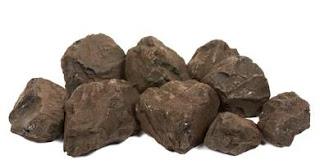LIGNITE
Lignite, also referred as Brown coal, is the lowest rank of coal.
It is identified by its brownish black color and texture. It is soft, has a woody structure and disintegrates on drying.
Lignite is characterized by low heat content, high percentage of moisture content, ranging from 30-50% with high oxygen content.
• It is formed due to bio-decay of vegetation, metamorphism and other geological processes over thousands of years. In these processes vegetation is converted to Peat - Lignite - Bituminous Coal - Anthracite Coal.
• Unlike Coal, Lignite is not traded in any significant extent in world markets, because of its relatively low heat content (which raises transportation costs on unit Energy content basis) and other problems related to transport and storage.
• Lignite is extensively used as a fuel in pit head thermal power plants and industries nearby.
• It is formed due to bio-decay of vegetation, metamorphism and other geological processes over thousands of years. In these processes vegetation is converted to Peat - Lignite - Bituminous Coal - Anthracite Coal.
• Unlike Coal, Lignite is not traded in any significant extent in world markets, because of its relatively low heat content (which raises transportation costs on unit Energy content basis) and other problems related to transport and storage.
• Lignite is extensively used as a fuel in pit head thermal power plants and industries nearby.
• It is formed due to bio-decay of vegetation, metamorphism and other geological processes over thousands of years. In these processes vegetation is converted to Peat - Lignite - Bituminous Coal - Anthracite Coal.
• Unlike Coal, Lignite is not traded in any significant extent in world markets, because of its relatively low heat content (which raises transportation costs on unit Energy content basis) and other problems related to transport and storage.
• Lignite is extensively used as a fuel in pit head thermal power plants and industries nearby.
HISTORY OF LIGNITE :
• Lignite, or brown coal, was discovered in eastern Germany at the end of the 18th century.
• First it was mined in open pits, which developed into small scale under ground mines.
• Around 1900 the first large-scale opencast surface mines were established 1805.
• First recorded use: Lewis & Clark conduct test burn of lignite.
• 1873 First commercial mine opens in Morton County: Lt.
FIGURE 1.2 ( Lignite mines)
HISTORY OF LIGNITE IN INDIA :
• Indian lignite deposits occur in the Tertiary sediments in the southern and western parts of peninsular shield particularly in Tamil Nadu, Puducherry, Kerala, Gujarat, Rajasthan and Jammu & Kashmir.
• The first lignite production in India started at 1961 in Tamilnadu (Neyveli).
• Largest production in India : Neyveli
• Indian lignite deposits occur in the Tertiary sediments in the southern and western parts of peninsular shield particularly in Tamil Nadu, Puducherry, Kerala, Gujarat, Rajasthan and Jammu & Kashmir.


Comments
Post a Comment